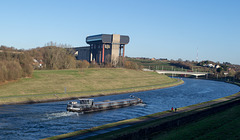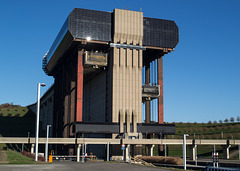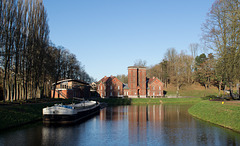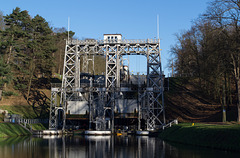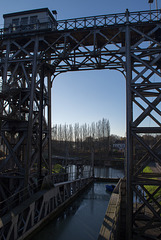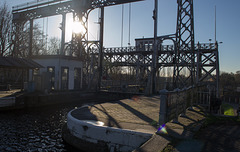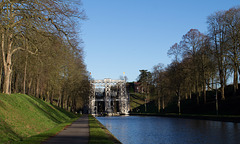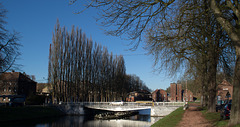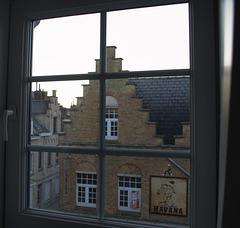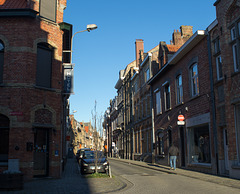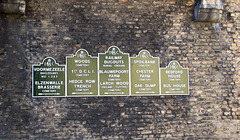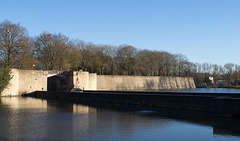
Europe2016
Belgium Strépy-Thieu lift (#0222)
| |
|
|
On the right side of the picture, the old Canal du Centre, on the left the new canal and the Strépy-Thieu lift.
Belgium Strépy-Thieu lift (#0220)
Belgium Strépy-Thieu lift (#0225)
| |
|
The massive Strépy-Thieu funicular boatlift, the only one of its kind in the world. The lift is actually two funiculars, one upstream and one downstream with each of the giant caissons counterweighted. You can roughly see the counterweights by comparing the top side of the lift on the right side in this (#0225) and the adjacent (#0235) picture; in #0235 where the caisson is about half way up, the counterweights are no longer visible at the top.
For more details see the adjacent picture and:
How it works: www.canal-du-centre.be/Education/Ast/En/commentcamarche.html
Belgium Strépy-Thieu lift (#0235)
| |
|
|
The boat lift was created because of the need to widen the canals to accommodate the larger (1350 tonne) barges that were used after WWII and to reduce the number of lifts that were needed on the old canal. The lift carries the barges up 73.15m (239 feet) with the lift portion of the crossing taking only 7 minutes.
The structure is open to the public with tours and crossings of the lift for much of the year, though it wasn’t open in the winter months that I was there.
The webpage for the lift includes an excellent description of the lift, possibilities for visiting it, and a Youtube aerial view of the lift (and of old lift #4 in operation). The Wikipedia page provides interesting additional information, and the Canal du Centre educational folder provides a wealth of additional information about the operation of the lift and the entire canal.
Lift webpage: voiesdeau.hainaut.be/en/placeofinterest/the-boat-lift-of-strepy-thieu
Wikipedia on the lift: en.wikipedia.org/wiki/Str%C3%A9py-Thieu_boat_lift
Canal du Centre: www.canal-du-centre.be/Education/En/dossierpedagogique.html
Belgium Canal du Centre historic lift #3 (#0242)
| |
|
|
The Canal du Centre approaching life #3. I didn't see a description of the building at the curve in the canal, though it is described as an engine room for the lifts with one person's pictures.
Belgium Canal du Centre historic lift #3 (#0244)
| |
|
|
What appears to have been something sort of akin to a depot for lift number 3 in Strépy-Bracquegnies.
Belgium Canal du Centre historic lift #3 (#0248)
| |
|
Description of the historic life. Note that these older lifts were built for 300 tonne barges, while the new lift is built for 1350 tonne barges. (A tonne is 1000 kilograms which is 2204 pounds, somewhat more than the American ton of 2000 pounds)
Belgium Canal du Centre historic lift #3 (#0246)
| |
|
|
Ascenseur (lift) N°3 Ancien Canal Du Centre, one of four historic lifts on the Canal Du Centre in the village of Strépy-Bracquegnies. I am mystified by the fact that these opened in 1917, which would have been the third year of WWI, and that they opened in an area very near to some of the largest battles in the war.
Updated 1/18/17: Thanks to Doug Wall for finding the information that this section was occupied by the Germans during WWI and it was the Germans that completed the lifts so as to use the canals for transport. Here's an excellent link about the overall Canal du Centre, courtesy of Doug: www.gamber.net/cyclebel/highlanw.htm
Belgium Canal du Centre historic lift #3 (#0249)
Belgium Canal du Centre historic lift #3 (#0252)
| |
|
At the top of lift #3; just before I took this there had been a man fishing from concrete platform next to the entrance to the lift; he didn't want to be in the picture (but was friendly).
Belgium Canal du Centre historic lift #2 (#0250)
Belgium Canal du Centre historic lift #3 (#0240)
Belgium Ypres (#0255)
| |
|
|
|
From my hotel window in Ypres, Belgium (Ieper is the official French and Flemish name, but Ypres is used in English). I've a strong interest in how combat and combat-related deaths are memorialized and since Ypres was the center of some of the heaviest fighting for WWI, it is surrounded by cemeteries and memorials related to WWI. The older part of the city is the main tourist area and the main tourism is the WWI sites. Despite that seemingly melancholic quality, it was a delightful small town to visit.
Belgium Ypres (#0257)
| |
|
|
The street next to my hotel in Ypres. Note that Ypres was almost leveled in WWI by German bombing; the historic structures seen here and in other pictures are reconstructions built after WWI.
Belgium Ypres Lille Gate (#0261)
| |
|
In the Lille Gate, 5 of the original Imperial War Graves Commission signs for nearby British military cemeteries. These signs date back to when pilgrimages to the historic WWI graves first began. See: www.greatwar.co.uk/ypres-salient/town-ieper-lille-gate.htm
Belgium Ypres Lille Gate (#0265)
| |
|
|
The Lille (Rijsel in Flemish) Gate (Rijselpoort) through the fortification surrounding the older part of Ypres. This gate is the only one to survive the bombardments of WWI and thus has been preserved in its historic state. See: www.greatwar.co.uk/ypres-salient/town-ieper-lille-gate.htm
Belgium Ypres Ramparts cemetery (#0267)
| |
|
|
The Ramparts Cemetery at the Lille Gate. The Ramparts cemetery is the only Commonwealth cemetery within the boundaries of the old town of Ypres. It began as a French cemetery in the first years of WWI (1914). The cemetery contains the graves of 198 Commonwealth soldiers killed between February 1915 and April 1918. See: www.greatwar.co.uk/ypres-salient/cemetery-ramparts.htm
Belgium Ypres Lille Gate (#0263)
| |
|
The Lille Gate and part of the fortification of the old city of Ypres. The curved parts of the gate (to the right of the bridge) date back to 1385. In 1914 the citizens of Ypres gathered at the gate to watch the advancing German armies. See: www.greatwar.co.uk/ypres-salient/town-ieper-lille-gate.htm
The water is from the rerouting of the Ieper river in the 11th century to provide both a defensive space and to allow for the routing of trading boats into the center of the city. See: www.greatwar.co.uk/ypres-salient/town-ieper-history.htm
Jump to top
RSS feed- Latest items - Subscribe to the latest items added to this album
- ipernity © 2007-2024
- Help & Contact
|
Club news
|
About ipernity
|
History |
ipernity Club & Prices |
Guide of good conduct
Donate | Group guidelines | Privacy policy | Terms of use | Statutes | In memoria -
Facebook
Twitter


